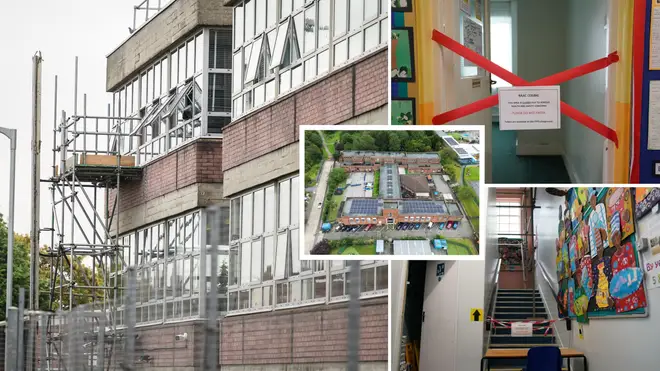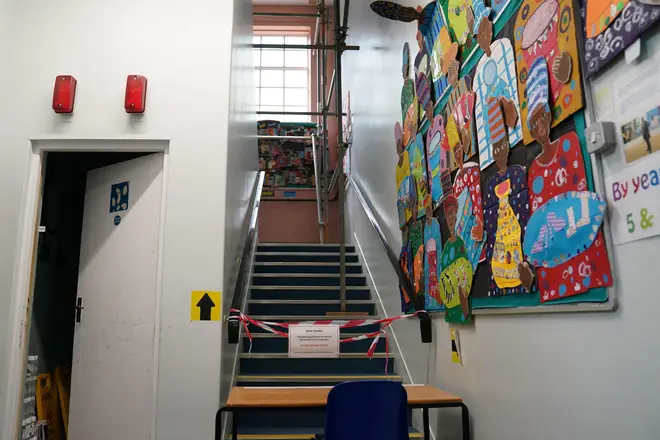
Paul Brand 10am - 12pm
2 September 2023, 23:49 | Updated: 7 September 2023, 11:32

Thousands of pupils affected by the concrete safety concerns in schools may have to endure ‘building site’ classrooms for years to come.
It comes after it emerged that safety measures have been put in place at 104 schools due to the presence of Reinforced Autoclaved Aerated Concrete (RAAC), while 52 schools have been shut.
Pupils will be taught outside of their classrooms or even off-site while urgent repairs are put in place amid fears that the RAAC that could cave in.
However, it has now been revealed that the schools affected could continue to use makeshift safety measures for years to come.
Ministers plan to leave the makeshift structural support devices in place at least for the medium term as the full scale of remedial work required is still unclear, according to The Telegraph.
This could mean classrooms are installed with ceiling ‘props’ to hold up roofs for years to come, so long as the buildings are deemed safe and signs of immediate danger have been removed.
At present there is no target date for eliminating the potentially dangerous material.
The Department for Education (DfE) has still not released a list of schools that might be affected by the unsafe concrete despite mounting pressure to do so.
A DfE spokesman said: “We are working very closely with schools and responsible bodies or other settings with cases of suspected or confirmed RAAC. Surveyors are available to investigate all suspected cases, and if confirmed, mitigations in some cases can be as simple as closing a single classroom.
Read more: Full list of schools affected by concrete safety fears so far as new closures confirmed

“Where further action is required, we are working with responsible bodies, including allocating a dedicated caseworker to every school, to get mitigations in place as quickly as possible and within weeks. The vast majority of pupils will stay in face-to-face education.”
But some critics have hit out at the refusal to publish a list.
“Now is not the time for withheld lists and the stonewalling of questions,” said Daniel Kebede, the general secretary of the National Education Union.
“They have to come clean and set out a coherent strategy, so that schools, children and parents can have certainty about when their building can return to normal.”
Sarah Olney, the Liberal Democrat Treasury spokesperson said it “beggars belief” that some children may be forced to learn in classrooms that look “more like a building site”.
A former headteacher and Tory special adviser at the DfE, said: “We can’t have displacements or pillars and other temporary measures obstructing the smooth functioning of school for long.”
It comes as headteachers across England are desperately rushing to try and find ways to safely reopen their schools ahead of the new term on Monday.
Those in schools affected by the unsafe concrete have been busy trying to rework timetables and find alternative classrooms to accommodate students ahead of Monday.
“We've been on the phone all day to temporary classroom companies... we have a very little playground [in one school] so actually getting 10 classrooms in there is going to be a challenge, and then there's the logistics of getting electricity run to it safely,” the CEO of Penrose Learning Trust said.

Parents in some schools have been warned that their children will have to eat school dinners in their classrooms, while children at one school in west London will have no choice but to bring in packed lunches as the canteen will be out of service.
Schools minister Nick Gibb said a list will be published but the government wants teachers to contact parents directly.
RAAC is a light and "bubbly" type of concrete that has sometimes been used in walls, floors and roofs.
But it has been compared to an aero chocolate bar in that it is weaker and less dense than other reinforced materials.
They were used in schools and other buildings, including hospitals, from the 1950s to the 1990s but it has a design life of about 30 years.
Nick Gibb revealed that a beam collapse in the summer led to the government deciding to take action, having previously believed the buildings were not at high risk.
Previously, in 2018, the roof of a school in Kent collapsed.
Students will still learn but will have their education disrupted by having to be taught outside of their usual buildings.
This could see them moved into temporary accommodation, away from affected buildings and classrooms, or put into different schools.